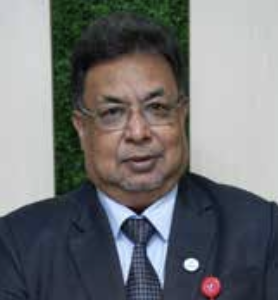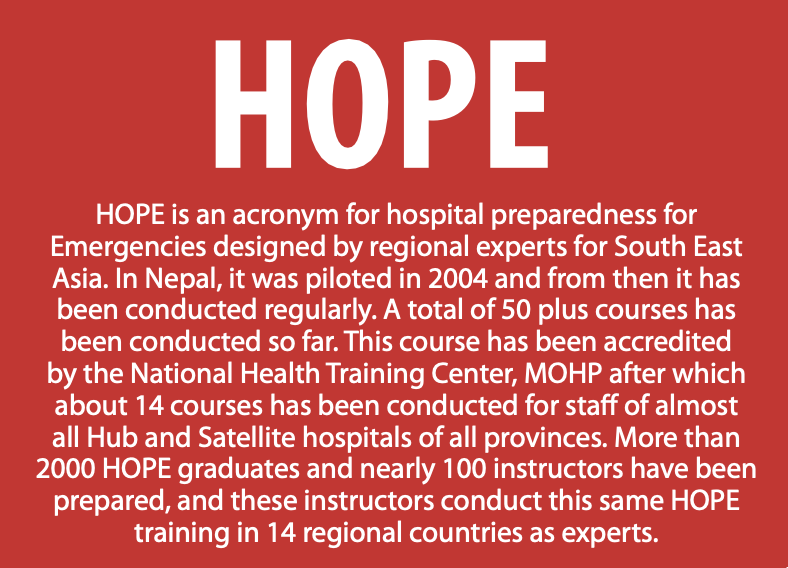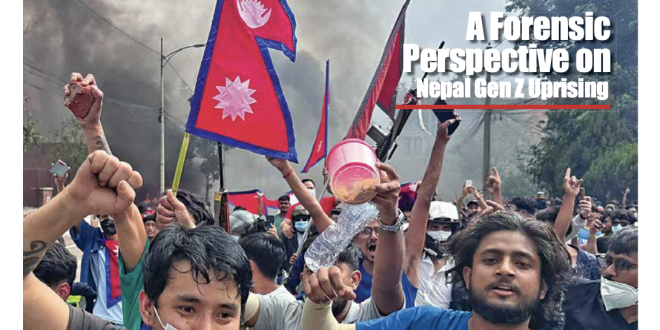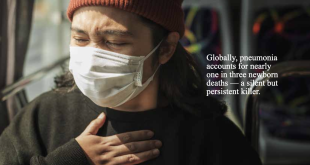
Prof. Dr. Pradeep Vaidya
Hepato-Biliary-Pancreatic Surgeon & Emergency Preparedness Leader
Prof. Vaidya is a surgeon and a leading figure in emergency and disaster preparedness in Nepal. As the President of the National Society for Emergency and Disaster Risk Management, he has been instrumental in strengthening Nepal’s health system resilience and hospital disaster readiness.
He is one of the key developers and regional instructors of the Hospital Preparedness for Emergencies (HOPE) course, a globally recognized program that equips healthcare professionals with the knowledge and skills to manage hospital operations during disasters and public health emergencies. Through his extensive training and advocacy, Prof. Vaidya has helped build a culture of preparedness across healthcare institutions in Nepal and beyond.
As a Hepato-Biliary-Pancreatic Surgeon at Norvic International Hospital, he combines his surgical expertise with his passion for health system strengthening and disaster risk reduction. Prof. Vaidya’s work bridges clinical excellence with strategic leadership, making him a vital contributor to Nepal’s advancement in emergency health management.
Nepal Gen Z Protests – Health Sector Response (September 2025)
In September 2025, widespread protests led by Gen Z erupted in Nepal after the government banned approximately 26 social media platforms. Protesters also voiced concerns over rampant corruption across all sectors of life. The unrest resulted in clashes, numerous injuries, and several fatalities. Hospitals across the country played a crucial role in managing the surge of victims, including both injured protesters and deceased individuals. Below is an overview of the health sector’s preparedness, response, and lessons learned.
Hospital Preparedness for Such Events
The Nepalese government has long been preparing hospitals for disaster events through training programs and structured planning:
- Staff Training: Most hospital staff, particularly in Hub Hospitals and their satellite hospitals, have been trained in the Hospital Preparedness for Emergencies (HOPE) course. This accredited disaster management course is recognized in Nepal and conducted in 14 regional countries.
- Hub-and-Satellite Network: To enhance coordination during disasters, the Ministry of Health and Population (MOHP) designates Government and Private hospitals in a hub-and-satellite system.
- Kathmandu Valley Hub Hospitals: Bir Hospital, Tribhuvan University Teaching Hospital, Patan Hospital, Shri Birendra Army Hospital, and Civil Service Hospital.
- Outside the Valley: Various provincial hub hospitals and their affiliated satellite hospitals.
- Hospital Disaster Preparedness and Response (HDPR): Both hub and satellite hospitals have undergone HDPRand HOPE training.
- HOPE Program Overview:
- Piloted in Nepal in 2004 and conducted regularly since.
- Over 50 courses conducted; approximately 14 courses for hub and satellite hospital staff across provinces.
- 2000+ HOPE graduates and nearly 100 instructors trained, who also deliver the course in 14 regional countries.
- HOPE Program Overview:
- Disaster Plans and Coordination:
- Each hospital develops its own disaster plan.
- Regular coordination meetings between hub and satellite hospitals are conducted by the Health Emergency and Disaster Management Unit (HEDMU) via the Health Emergency Operation Center (HEOC).
- Tabletop exercises and drills have been conducted in most hospitals to simulate disaster scenarios.
Challenges: Despite training, disaster events are infrequent, and hospital management may not prioritize disaster preparedness. Frequent staff transfers or promotions can result in outdated or difficult-to-implement disaster plans during actual emergencies.
Key Statistics and Scope of the Incident
- Deaths: 74 fatalities reported across various hospitals nationwide.
- Injuries: Over 2,000 people injured, many requiring hospitalization; some discharged after treatment.
- Hospital Involvement: Injured patients were treated in 28–52 hospitals across the country.
- Major Hospitals Handling Cases in Kathmandu: Civil Service Hospital, National Trauma Centre, Everest Hospital, Kathmandu Medical College, Tribhuvan University Teaching Hospital, and others.
Hospital Response and Operational Measures
Emergency Mode Activation:
- Hospitals activated disaster-response protocols.
- Hospital Incident Command System was activated in several hospitals.
- At the Trauma Centre, doctors, nurses, and paramedics were fully mobilized.
- Non-emergency surgeries were halted to prioritize critical patients.

Resource Realignment
Surge Capacity Management:
- Re-allocation of Space: Extra spaces were used, such as placing injured patients on mattresses on floors, when patient influx exceeded hospital capacity.
- Shifting Staff: Doctors and medical personnel were called in from nearby hospitals to help manage the increased patient load at affected hospitals.
Management of Critical Injuries
Proper Triage:
- Many patients presented with bullet wounds, including injuries to the head, chest, and abdomen.
- Hospitals performed numerous emergency surgeries, often using multiple operating theatres simultaneously.
Referral System:
- Patients requiring specialized surgery were referred to appropriate hospitals.
- Some patients, seeing crowds at onsite hospitals, self-referred to other hospitals for quicker care.
Pre-Hospital Care:
- Ambulance services effectively referred critical cases to appropriate hospitals, ensuring better management despite risks to staff and vehicles in some locations.
Forensic / Post-Mortem Work
- Tribhuvan University Teaching Hospital’s forensic unit conducted autopsies on deceased victims, identifying some while others remained unidentifiable.
Coordination and Alert Systems
- The Health Ministry ordered all hospitals to remain on high alert, mobilized ambulance services, and coordinated patient transfers.
Psychological / Emotional Impact Among Health Workers
- Doctors and nurses were emotionally affected—some broke down, while others worked extended hours without rest.
- Debriefing: HEDMU recommended cold debriefing within two weeks of the event to identify gaps and improve future disaster plans.
Free Treatment Policy
- The Health Ministry issued circulars directing all federal hospitals to provide free treatment for those injured in the protests.
- All hospitals, including private institutions, were required to treat victims free of cost and later claim reimbursement after submitting accurate documentation.
- Although most private hospitals complied, there were some reports of charging patients for medicines while waiving hospital service fees.
What Worked
- Free treatment order removed financial barriers, allowing victims to seek care promptly.
- Mobilization of multiple hospitals prevented any single facility from being overloaded.
- Activation of disaster response protocols, even if imperfect, demonstrated good preparedness.
- Forensic capacity helped identify deceased individuals, providing closure to families.
- High alerting and patient transfer protocols allowed triage and stabilization of critically injured patients in major hospitals.
Improvements Required
Ambulance & Pre-Hospital Care:
- Strengthen ambulance networks with improved dispatch systems for faster response and better pre-hospital triage.
- Implement an Integrated Emergency Medical System (IEMS) led by HEDMU to refer critical patients directly from the injury site to appropriate hospitals for early, specialized care.
- Although Nepal Ambulance Service in Kathmandu provides free services within the valley, broader coverage and integration are necessary.
- Further Improvements Required
1. Ambulance Services & Pre-Hospital Care
All ambulances should be fully equipped with EMT personnel and necessary medical equipment.
Ambulance services during disasters should be free, well-manned, and fully equipped.
Upgrade most ambulances to B-level, with EMTs and basic medical equipment.
Ensure ambulances are strictly used to transport injured patients to maintain public trust.
Educate the public on the importance of ambulances in saving lives to prevent damage and threats to staff.
Train paramedics and community members in First Aid and Basic Life Support (BLS) to enhance pre-hospital care.
2. Surge Capacity & Infrastructure
Many hospitals lack sufficient space to handle a sudden patient influx; overflow onto floors was common.
Pre-planned surge capacity management should be incorporated into hospital disaster plans.
Operating theatres may become bottlenecks; adding more theatres or establishing shared regional surgical centers could help during mass emergencies.
3. Equipment & Supplies
Ensure adequate trauma kits, surgical tools, wound care materials, and imaging (X-ray/CT), particularly for bullet or internal injuries.
Maintain stockpiles of consumables: drugs, dressings, anesthesia, and blood products.
Hub hospitals often have equipment containers that are not replenished; hospitals should restock promptly with government support through funding and policy enforcement.
4. Human Resources
Train and maintain a sufficient number of trauma surgeons, emergency physicians, anesthetists, and nurses to handle mass casualties.
Develop postgraduate courses in relevant emergency and trauma disciplines.
Utilize the Hub and Satellite system to temporarily borrow staff during disasters.
Train more staff in disaster medicine, triage, and mass casualty management.
Community training in First Aid and BLS is essential.
5. Coordination and System Preparedness
Establish clear, practiced protocols for mass casualty incidents, covering triage, transfer, command structure, and resource sharing between hospitals.
Activate the Incident Command System within HEDMU to ensure centralized coordination.
6. Coordination and System Preparedness (Continued)
- HEDMU should coordinate through HEOC and Provincial Emergency Operation Centers (PHEOC) during disasters to manage human resources, logistics, and IEMS.
- Hospitals should be monitored by HEDMU to ensure treatment standards are maintained even under difficult conditions.
7. Forensic and Identification Capacity
- Enhance the ability to quickly perform autopsies, identify bodies, and assist families.
- Strengthen DNA testing facilities for unidentifiable cases.
- Establish clear protocols for handling bodies and preserving evidence.
8. Free Treatment and Financial Protection
- Ensure the directive for free treatment is implemented uniformly across public and private hospitals.
- Implement systems to reimburse hospitals so that providing free or low-cost care does not strain finances.
9. Communication and Information Management
- Improve public communication: inform the public which hospitals are available, referral paths, and resources.
- Maintain internal hospital communication: OR availability, on-call staff, and emergency procedures.
- Inform the public about ambulance services, blood requirements, and updates on hospital status.
10. Security & Safety in Hospitals
- Hospitals can become chaotic during unrest; crowd control is essential to protect patients, staff, and ambulatory pathways.
- Establish protocols to secure entrances, manage visitor flow, and designate areas for patients and visitors.
- Create awareness among the public and law enforcement that hospital premises are for medical management only.
11. Post-Trauma Psychological Support
- Provide short-term and long-term psychological support for healthcare workers.
- Designate hospitals to offer free post-trauma consultations for a month or longer if required.
12. Debriefing
- HEDMU and MOHP should conduct debriefing sessions with all major stakeholders to evaluate what worked and what needs improvement.
- Accountability and lessons learned will strengthen future disaster response.
13. Practice and Drills
- Conduct regular drills with realistic scenarios, including civil unrest, violence, epidemiological disasters, and multiple casualties.
- Drills should include various hospitals, hub and satellite networks, communities, ministries, public and armed forces, potentially culminating in valley-wide exercises.
14. Legal, Ethical, and Human Rights Considerations
- Maintain proper record-keeping to document injuries, treatment, and referrals.
- Monitor treatment standards for detainees and injured protesters.
- Document wound types (live/rubber bullets) for human rights investigations.
- Ensure treatment records are available for government reimbursement purposes.
Conclusion
The Gen Z protests in Nepal placed hospitals under acute strain. Despite this, many hospitals adapted quickly, mobilized resources, provided free care, and activated disaster response systems.
However, the crisis revealed gaps in infrastructure, planning, supply chains, staffing, pre-hospital care, and coordination. Strengthening these areas will prepare Nepal’s health system for protests, civil unrest, natural disasters, mass accidents, and epidemiological crises.
Regular practice of disaster risk management systems, including the Incident Command System (ICS), is essential to ensure readiness for future emergencies in a country with challenging infrastructure, geography, and resource limitations.
 Medicosnext
Medicosnext




